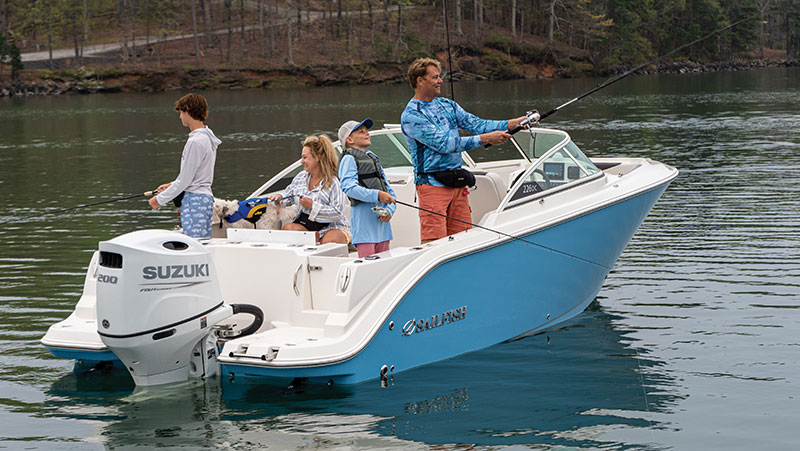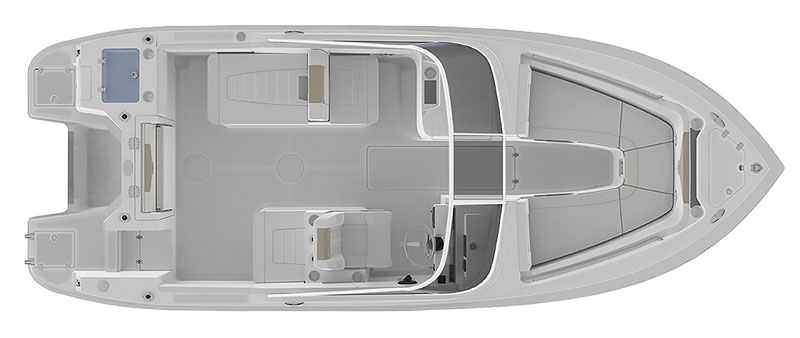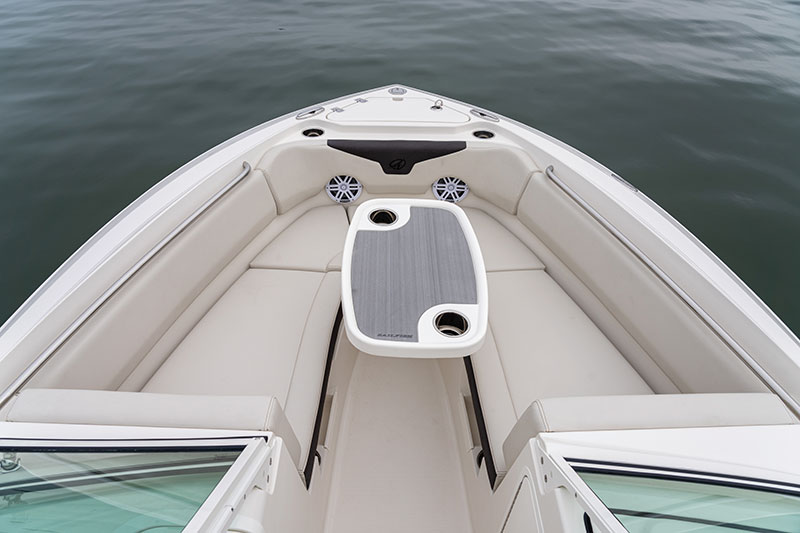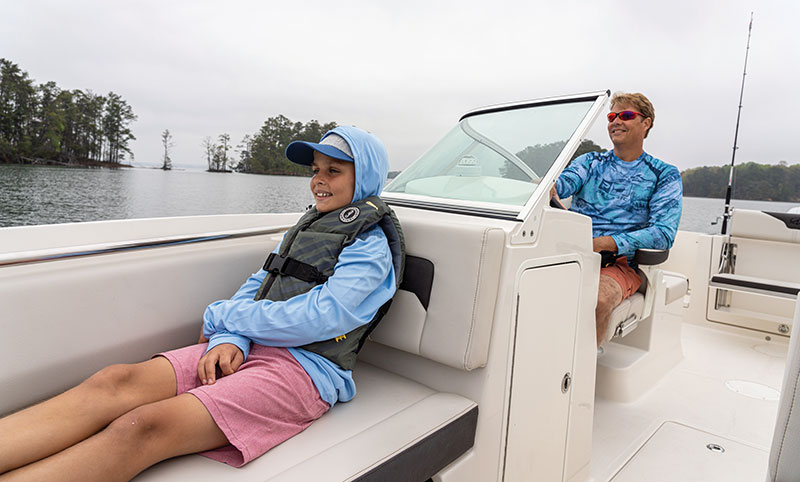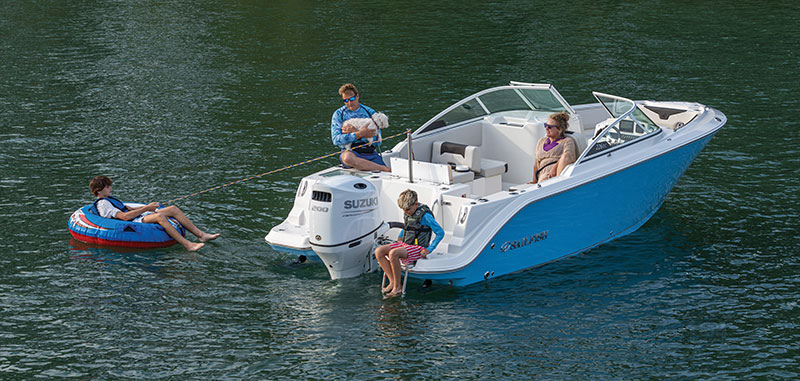A floating sports utility vehicle.
by Alan Wendt
“Assignment in Cairo,” read the email.
Photos Courtesy of Sailfish
Mystery and intrigue. “Test the new Sailfish 226 Dual Console (DC).”
My go bag ever ready, I was off to the airport not even questioning the location of the Flint River (must be a little-known tributary of the Nile) where I was to meet the boat and crew from Sailfish.
Alas, the ticket was not for Egypt, but rather AVIS, and ahead was a five-hour drive to Georgia where I learned quickly that Cairo was pronounced Kay-Row.
Buoyed by a boat ramp sign proclaiming this the Bass Capital of the World, my spirits soared again. Unfortunately, Ra, the sun god of ancient Eqypt, was on holiday and replaced by Hapi, the god of the annual flooding of the Nile. Fifty-knot winds and sheets of stinging rain for three consecutive days sent us back to the Sailfish factory where the true treasure was about to be discovered.
 Sailfish pedigree
Sailfish pedigree
Sailfish has an impressive collection of Dual Console models, and the 226 DC is an entry-level model built for freshwater migration to saltwater life, for a boater who wants to wash and go. The concept for the 226 DC was propelled by the nationwide trend of moving away from a typical runabout to boats more in step with SUVs appealing to multi-generational families and differing watersports interests. To be sure, it’s every bit a fish boat. From the 21-gallon livewell, numerous rod holders, insulated bow fishboxes (that double as a cooler when not fishing) and the optional 7-inch Garmin GPS chartplotter and bottom finder, this vessel lives up to the Sailfish pedigree.
But there is so much more. A one-of-a-kind portside lounger provides fore and aft directional seating and quickly converts into a full lay-down sunpad. An aft fold-away seat with bilge garage trunk access is just the beginning of family-friendly inspired features. These include a Baja Sand Bar cooler in the transom swim platform, a standard transom pressurized freshwater shower, and an optional telescoping tow pylon to pull tubers and skiers. Up front, the bow has comfortable twin lounges, an optional bow table for drinks and snacks, and insulated storage below each seat.
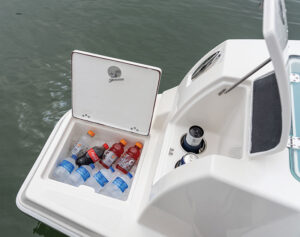 The true party pleaser is the enclosed private head with a standard porta-potti located just left of the console. You won’t find many of these inside a 23-foot boat.
The true party pleaser is the enclosed private head with a standard porta-potti located just left of the console. You won’t find many of these inside a 23-foot boat.
Captains will quickly gravitate to the helm protected by the wraparound windshield. All standard switches, a compass and instrument readouts put you firmly in control. Passengers will find well-placed cupholders and USB plugs to send tunes to the stereo or keep devices charged to their heart’s content.
Regardless of use, the 226 DC sports higher gunnels and a deeper cockpit that instills a sense of security for all aboard.
Hidden treasure
Few boat buyers get a chance to watch their boat made, step by step. Yet, it’s here where you witness artisans create the magic and instill confidence on why a boat builder infuses Kevlar in the keel and bow for strength and resilience when the boats face punishment from the waves and angry seas.
One of the secret treasures I found is a 3-inch-wide band of Trevira quad-axial fiberglass applied to where the deck is mated to the hull. Once bonded to the resin and cured, it has the tensile strength of aluminum precisely where the screws fasten these two pieces together. You’ll never see this band, except on the factory floor.
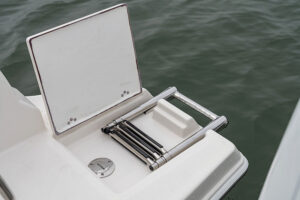 Sailfish uses a wood-free stringer system where bulkheads, main beams and cross members fit together like a jigsaw puzzle. No wood means zero risk of rot or warp. Sailfish backs its hulls with a 10-year limited warranty. The stringer system is what gives a hull strength. Unlike some fishing boats that are heavy, this robust system allows a hull to be built lighter, improving fuel efficiency.
Sailfish uses a wood-free stringer system where bulkheads, main beams and cross members fit together like a jigsaw puzzle. No wood means zero risk of rot or warp. Sailfish backs its hulls with a 10-year limited warranty. The stringer system is what gives a hull strength. Unlike some fishing boats that are heavy, this robust system allows a hull to be built lighter, improving fuel efficiency.
The 226 DC sits on the sixth-generation Variable Degree Stepped (VDS) hull. With three hulls in one, the platform contributes to a balance of stability and performance. A steep 24-degree entry point angle peels open the aggressive water, while the second surface enables air to flow efficiently under the hull. Call it aeration, less friction translates into better fuel economy. The third hull step is positioned at a flatterer 22 degrees, enhancing stability at rest.
This style of hull does require more positive trim to get you on plane. Sailfish has a dedicated YouTube video for new owners to learn the trick of acceleration. Sailfish offers dealers the option of a single Mercury, Yamaha or Suzuki 150- or 200-hp outboard. Our test boat had a larger engine package delivering top speeds around 40 to 42 mph, according to Sailfish’s performance data. I’ve tested other Sailfish models with the same hull. Each rides the rail in a hard turn and feels sporty.
Test drive any boat before you buy. Better yet, take a factory tour and you’ll truly appreciate the quality and value that goes into a Sailfish.

Ample leg room for adults seated in the cockpit.
Clever use of multiple storage areas.

A larger chartplotter screen at the helm would be nice.
Specifications
- LOA: 23′
- Beam: 8’6″
- Draft: 18″
- Weight: 5,150 lbs.
- Fuel Capacity: 108 gals.
- Water Capacity: 12 gals.
- Max Power: 200 hp
- Base Price: $100,443
- Website: sailfishboats.com
Dealers
- Jefferson Beach Yacht Sales
jbys.com - North Shore Marina
northshoremarina.com - SkipperBud’s
skipperbuds.com


